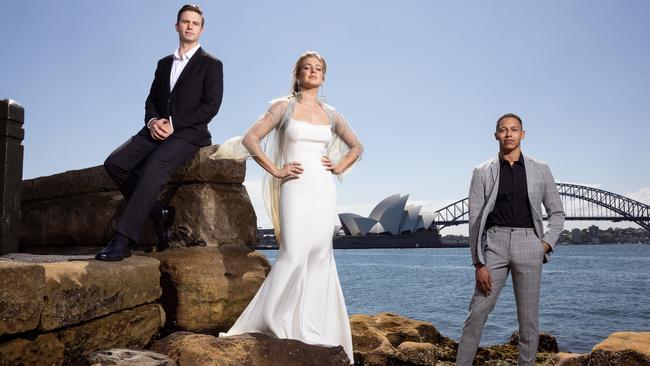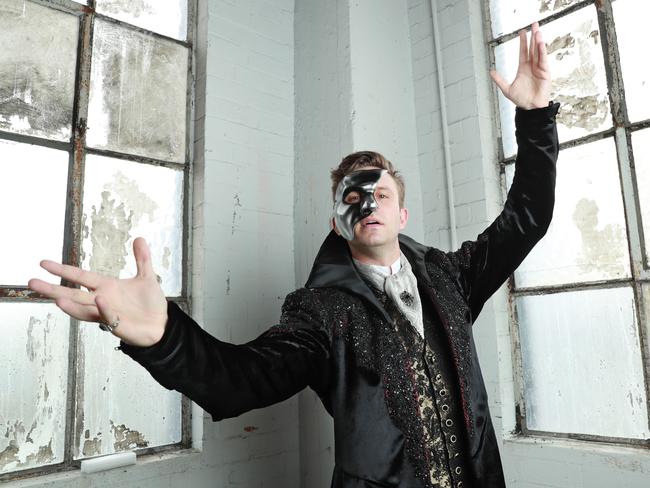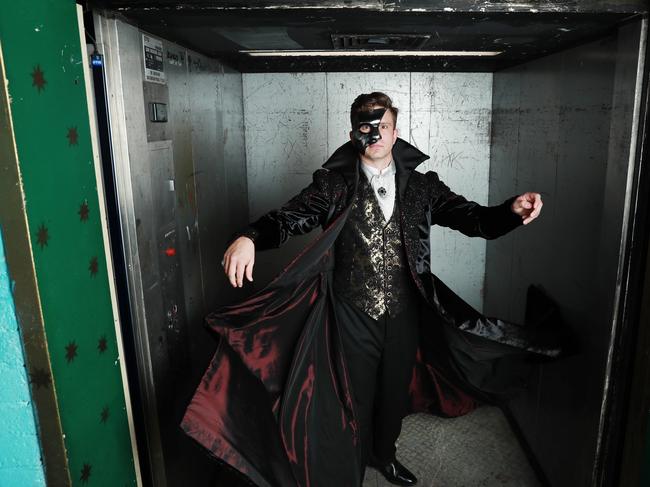The Phantom of the Opera on Sydney Harbour is a fresh look at the classic musical
Putting Andrew Lloyd Webber’s hit musical on the harbour stage has involved a break with tradition – including the Phantom’s white mask.

Joshua Robson is refreshingly undaunted. Unfazed. He is about to tackle the biggest role of his career – the Phantom in Andrew Lloyd Webber’s musical spectacular The Phantom of the Opera – and has some big shoes to fill. The character was created by Michael Crawford for the original West End production in 1986. Anthony Warlow was Australia’s first and much-loved Phantom in the early 1990s – Robson was a baby when his grandparents took him to see the show at the Princess Theatre in Melbourne.
But Robson, 31, is not so concerned about comparisons with famous Phantoms of the past. He’s excited, more so, about the prospect of creating the role anew. This will be a Phantom as you’ve never seen him before.
The ever-popular musical is the latest presentation in the Handa Opera on Sydney Harbour series, and will quite possibly be the first time anywhere that Phantom has been staged outdoors, arena-style. Certainly, few settings are as gorgeous as Sydney Harbour and – assuming Sydney’s long spell of rain ends before opening night on March 25 – visitors will enjoy the music of the night under a starry sky.

“So many people have played these roles,” Robson says of the Phantom’s long performance history. “You don’t know if people are going to love our portrayals, but they can’t really be compared, because our version is completely different. There are brilliant performers, but this is my version, a brand new version.”
This Phantom is new for several reasons. The outdoor stage has meant rethinking many aspects of the show that only work in a conventional theatre. Another factor is copyright over Maria Bjornson’s stage designs from the original 1986 production, such as the famous falling chandelier. Those things can’t be used in this production – which means director Simon Phillips and designer Gabriela Tylesova have had to come up with an entirely new look for the show. And it includes the Phantom’s iconic mask.
“It can’t be white,” Phillips says. “It seems to me a bit of a quibble in terms of copyright, to be honest, but that is the line that has been put in the sand …
“There are great constraints about the design not infringing on the copyright of the original team. There are things that, within reason, have to be different on some level from the original. But where things are not absolutely defined by the text there’s a lot of room to move. And there’s room for interpretation on many levels.”
Staging the Phantom over the water on Sydney Harbour also presents challenges. Any fanciful notions you may have about the Phantom and Christine sailing across the harbour on a candlelit gondola will be blown out of the water.
“What I’ve noticed at HOSH is that there’s an extent to which you can’t really use the water,” Phillips says. “If you put things on the water, you actually can’t see them. And when you think, ‘Good, the Phantom can actually bring Christine across a lake – not just a lake, a harbour – in the boat’, a tugboat goes past, there’s a choppy sea, and they fall into the water. It’s environmentally beautiful for the piece, but it isn’t actually of practical use.”
Phillips has vast experience in directing theatre, opera and musicals, including such crowd-pleasers as Priscilla Queen of the Desert, Muriel’s Wedding and the Phantom “sequel”, Love Never Dies. Perhaps surprisingly, given his long career, he has never directed an arena-style production. He has been rehearsing with the cast – it also features Georgina Hopson as Christine and Callum Francis as Raoul – in a stadium at Olympic Park before moving the rehearsals to the harbour stage at Mrs Macquarie’s Point.
He observes that the structure of The Phantom of the Opera is characteristic of modern musical theatre, which is often “made more than it is written”. He means that instead of being the work of a solitary author or composer, a musical is a collaborative venture incorporating music, lyrics, direction and scenic elements.
And Phantom, having grossed more than $8.2bn in box office worldwide, is a very successful example of the genre. The scenes are intended to flow seamlessly from one to the next, such as the sequence that links the musical numbers Angel of Music, The Phantom of the Opera and The Music of the Night.

Many scenes have had to be rethought for the outdoor stage, which lacks a fly tower and the technology available in a sophisticated indoors theatre. Another factor, Phillips says, is that the harbour stage is about four times bigger than that of most indoor theatres.
“It’s quite a challenge to work out,” he says. “A piece of music that got you from one side of the stage to the other in the indoor production is not long enough to get you from one side of the stage to the other in an outdoor production. Andrew (Lloyd Webber) has been very open to where there might need to be some extensions if we just can’t manage it. We are keeping him posted, and making suggestions as to how we might buy ourselves a bit of time musically.”
Working out how to move his principal cast and chorus across a huge area has also meant Phillips is spending a lot of his time at rehearsals up a ladder. “When I do a production for a big theatre, I’m always a little conscious that I’m directing two shows – one for the people in the stalls who have a somewhat more intimate experience of it, and one for people in the circle who have more of a sense of the patterns. This is that on a massive scale. You are making large, choreographic shapes in the staging so that it reads on a grand scale.”
Robson has previously appeared in musicals including Muriel’s Wedding and Dream Lover: The Bobby Darin Musical, both of which Phillips directed. He says the Phantom is a “deceivingly difficult” role. The singer, naturally a baritone, had coaching sessions with Opera Australia’s Lyndon Terracini and the show’s conductor, Guy Simpson, to help him uncover the darker shadings in his voice. They started with the Phantom’s signature song, The Music of the Night, and worked through the rest of the musical numbers.

“It’s the darker quality to the sound – almost an operatic tone – rather than a music-theatre sound,” he says. “It’s about the placement of where the sound is coming from – you are using the soft palate and the lower larynx to be able to engage that darker quality. I thought it would be difficult, but my voice naturally sits there. Once we found that sound with Music of the Night, we applied that to the rest of the material.”
The other challenging aspect of the role is the Phantom’s psychology – how to make him both frightening and vulnerable.
“He’s very misunderstood – he sees the beauty in life, and everyone sees the beast in him,” Robson says. “That’s the hardest thing to portray. You need the audience to be able to connect with you, but some of this material is so dark, it’s a challenge to be able to keep the audience on side, because of the darkness of the stuff this character is doing.”
The mask is a crucial part of the Phantom’s costume, disguising his facial disfigurement. Because Bjornson’s original designs can’t be used, Robson will have masks of different colours, including silver.
Phillips says he and Tylesova have opted for a more restrained approach to the Phantom’s costume, with the intention of maintaining a sense of gravitas about him.

“In the original, the Phantom did a lot of dressing up – and not just in the famous Masquerade scene where he appears as the red devil,” Phillips says. “We’re keeping him more classical. The only gesture towards that idea is the mask – he uses different masks for certain occasions. In Masquerade, he doesn’t wear the big skull that he wore in the original production, but he wears a red version of his own classic mask. So there’s an element of dressing for the occasion – but it’s far more classical than he is in the original.”
Phillips’s Phantom is the first of two productions of the musical opening this year. Opera Australia is also presenting Cameron Mackintosh’s new version of Phantom, opening at the Sydney Opera House in August before transferring to Melbourne in October. Phillips says the musical endures because of its irresistible mix of romance and high drama.
“Because it’s based on a gothic melodrama, it has a lot of thrills and spills – but it has at the centre of it an absolutely compelling love triangle which is supported by some truly beautiful music,” he says. “You get this combo that works in the right balance of ingredients – the lyricism and the high drama.”
The Phantom of the Opera is at Mrs Macquarie’s Point, Sydney, March 25-April 24.
